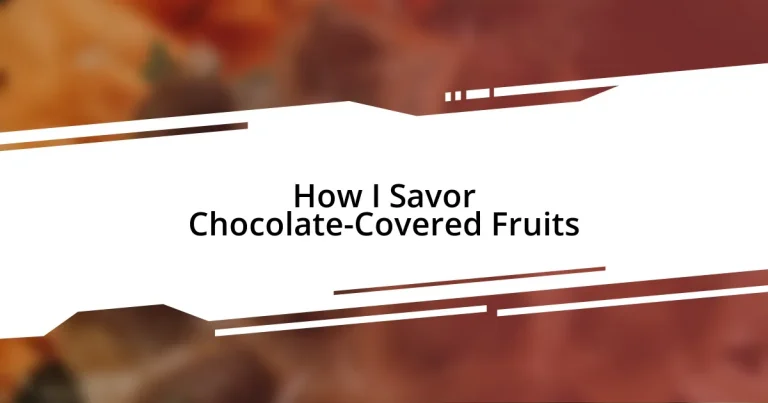Key takeaways:
- Choose fresh, complementary fruits for chocolate dipping, such as strawberries, raspberries, bananas, and exotic options like kiwi and mango.
- Key preparation steps include thoroughly washing fruits, ensuring they are at room temperature, and slicing them for optimal chocolate coverage.
- Select high-quality chocolate with a cocoa content of 70% or higher for a richer flavor, and focus on few ingredients for best results.
- Properly melt and temper chocolate to achieve a smooth, glossy finish, and experiment with various flavor combinations to enhance the overall experience.

Choosing the Right Fruits
When it comes to choosing fruits for chocolate dipping, I often gravitate towards berries, especially strawberries and raspberries. Their vibrant colors scream freshness, and I’ve found that the tartness of raspberries beautifully balances out the sweetness of chocolate. Have you ever bitten into a chocolate-covered raspberry? It’s a burst of flavors that I can never resist.
I also like to experiment with bananas and oranges. Bananas provide a creamy texture that pairs perfectly with dark chocolate, while oranges offer a refreshing zing. Remember the first time you tried a chocolate-covered orange slice? That combination of zesty and sweet can truly elevate your dessert experience. It’s moments like these that stick with me and keep me coming back for more.
Don’t overlook the exotic options, either! Fruits like kiwi and mango can add an unexpected twist. I recall my first chocolate-dipped mango; it felt like a tropical getaway right in my kitchen. How exciting is it to incorporate different textures and tastes in your chocolate-covered fruit creations? Embracing variety not only makes the experience more enjoyable but also allows you to discover new favorites.

Preparing the Fruits for Coating
Preparing the fruits for coating is a crucial step that can make or break your chocolate-dipping experience. I’ve learned that washing the fruits thoroughly is essential, as this removes not only dirt but also any residues that could prevent the chocolate from adhering properly. I remember the time I skipped this step with some strawberries; the chocolate just slid right off. A good rinse followed by a gentle pat dry can dramatically change the outcome.
Once the fruits are cleaned, another key tip is to ensure they’re at room temperature. Cold fruits can cause the chocolate to harden too quickly, resulting in an uneven coating. I still chuckle at the memory of my first attempt with chilled fruit. I must have been too eager to coat the strawberries without giving them time to warm up. The result? A clumpy mess that was still delicious but far from the smooth, glossy treat I envisioned. Allowing your fruits to relax a bit goes a long way in achieving that enticing sheen.
Lastly, don’t forget to consider the cut of the fruits. Slicing bananas into thick rounds or strawberries into halves can expose more surface area for the chocolate, so you get a more satisfying ratio of fruit to chocolate in every bite. I always recall my friends’ delight when they bit into those perfectly coated banana slices at a gathering. It turned a simple snack into a highlight of the evening. Making these small adjustments can enhance your overall enjoyment of chocolate-covered fruits.
| Preparation Step | Importance |
|---|---|
| Washing the Fruits | Removes residues, ensuring better chocolate adhesion |
| Bringing to Room Temperature | Prevents chocolate from hardening too quickly, resulting in a smooth coating |
| Slicing Fruits | Increases surface area for an optimal chocolate-to-fruit ratio |

Selecting Quality Chocolate
Selecting Quality Chocolate
Selecting the right chocolate is where the magic truly begins. I always remember the first time I splurged on high-quality dark chocolate—it was like tasting a symphony compared to the ordinary stuff. The richness and depth transformed my chocolate-covered fruits into something extraordinary. When you’re choosing chocolate, look for the type with a high cocoa content, often 70% or higher. This ensures a more robust flavor and a satisfying depth that pairs beautifully with fruits.
Quality chocolate should ideally have few ingredients. Think of it this way: if you can’t pronounce it, it probably doesn’t belong in your chocolate. Here are a few tips to help you make the best choice:
- Cocoa Percentage: Aim for a higher cocoa content (70% or more) for richness.
- Ingredients: Select chocolate with minimal ingredients—cocoa mass, cocoa butter, sugar, and perhaps a dash of vanilla.
- Texture: Look for a smooth texture; it should melt in your mouth, creating a delightful experience.
- Aroma: A strong, inviting aroma indicates quality. Take a moment to breathe in the scent before you dive in!
- Taste: Finally, don’t be shy—always taste a small piece before using it. This way, you’ll know exactly how it will complement your fruits!
Every chocolate-tasting adventure I embark on teaches me something new. The first time I tried artisanal chocolate at a local shop, I was taken aback by how much flavors could vary—from fruity notes reminiscent of berries to rich, earthy undertones. Each bite sparked a captivating conversation with my palate, making me eager to dive into more experimenting with different chocolates and fruits. The exploration is just as rewarding as the end result, and it’s a journey worth savoring.

Melting and Tempering Chocolate
Melting chocolate seems simple, but I’ve learned that it’s a bit of an art form. I remember melting chocolate untempered in the microwave during my early attempts, thinking it would be quick and easy. Instead, I ended up with a grainy, seized mess! Now, I prefer a double boiler for a gentle and even melt. The key here is to avoid overheating, which can lead to that dreaded texture downfall.
When it comes to tempering chocolate, this process is vital for achieving that delightful shine and satisfying snap. I’ve had my share of tempered failures, which usually ended with chocolates losing their glossy appeal. However, finding the right technique makes all the difference. I personally enjoy the tabling method, spreading melted chocolate on a marble surface and mixing in solid chocolate chunks to cool it down while maintaining that beautiful, velvety finish.
Do you ever find yourself wondering why some chocolate-covered treats have that irresistible sheen, while others look dull and lifeless? I certainly have! The secret lies in tempering. This process involves carefully controlling the temperature to stabilize the cocoa butter crystals. When done right, you achieve that perfect shiny coat, enhancing both taste and presentation. Trust me; seeing a beautifully tempered chocolate-covered fruit is just as rewarding as eating it!

Dipping Techniques for Fruits
Dipping fruit into chocolate can feel like a whimsical dance. I remember the first time I dipped strawberries; I was so eager that I practically submerged them in the bowl. The trick? A slow, gentle dip allows the chocolate to adhere evenly and beautifully. I found that holding the fruit at the stem helps with control, making it easier to get just the right coating without overwhelming the fruit’s natural sweetness.
Have you ever tried dipping fruits at different angles? That little adjustment truly transforms the experience. I discovered that angling the fruit helps create a more artistic presentation, with chocolate drips adding a playful touch. Plus, it allows for better coverage, especially with fruits like bananas and apples, which can be tricky. This little technique makes me feel like I’m decorating a masterpiece rather than just dipping fruit!
Timing matters too. When I first began my dipping adventures, I often left the chocolate too long on the fruit, resulting in unsightly drips. Now, I dip and gently lift, letting excess chocolate fall off before placing it on parchment paper to set. The anticipation builds as I watch the chocolate cool and harden, transforming into a glossy shell that’s both beautiful and delicious. Every time I take that first bite, it’s a delightful reminder of the joy found in these simple techniques.

Flavor Combinations to Explore
When exploring flavor combinations, don’t underestimate the magic of citrus fruits like oranges or lemons paired with dark chocolate. I still remember the first time I combined a juicy orange slice with a rich, dark chocolate coat. The vibrant tartness of the citrus perfectly cut through the decadent sweetness, creating a harmonious balance that left me craving more. Have you ever tasted that delightful contrast between tangy and sweet? It’s a flavor symphony on your palate that I can’t recommend enough.
Another combination that always excites me is strawberries dipped in white chocolate with a sprinkle of sea salt. The creamy sweetness of the white chocolate plays beautifully with the ripe, juicy strawberries, while the hint of salt elevates the entire experience. This pairing resonates deeply with me because it encapsulates the essence of indulgence—I can’t help but feel a little luxurious savoring each bite. Next time you’re looking for a flavor boost, give this combo a try; it’s truly something special.
For a more adventurous trail, don’t shy away from incorporating spices like chili powder or cinnamon into your chocolate mixture. I once added a dash of cayenne to my melted chocolate, inspired by a friend who raved about spicy chocolate treats. The result was a thrilling kick that lingered pleasantly after the rich chocolate dissolved. This bold twist transformed what could have been an ordinary experience into an evening of delightful surprise. Why not step outside your comfort zone and experiment with spices to elevate your chocolate-covered fruits? You might just find your new favorite flavor adventure!

Storing and Serving Chocolate-Covered Fruits
Storing chocolate-covered fruits properly is crucial for maintaining their deliciousness. I’ve learned the hard way that moisture is the enemy. After dipping, I place my fruits on a parchment-lined tray and let them cool completely before refrigerating. This not only helps set the chocolate but also ensures they stay fresh longer. Have you ever bitten into a soggy chocolate-covered treat? It’s not a pleasant experience!
When it comes to serving, I like to present my chocolate-covered fruits with a flair. Picture this: a beautiful platter adorned with an array of colorful fruits, each lovingly coated in rich chocolate. I often drizzle some extra melted chocolate over the top for a decorative finish—it’s those little touches that make it feel special. If you’re hosting a gathering, consider arranging them into a beautiful centerpiece. Isn’t it fun how something so simple can elevate any occasion?
Timing is key, too. I’ve found that chocolate-covered fruits taste best when enjoyed fresh, ideally within one to two days of making them. However, I’ve stored them in an airtight container for up to a week—although they lose some of their initial crispness. Have you had the chance to enjoy them right after dipping? The way the chocolate shell breaks as you bite into the fruit can be pure bliss! So, why not indulge in the experience as soon as possible? It turns each bite into a mini celebration.














